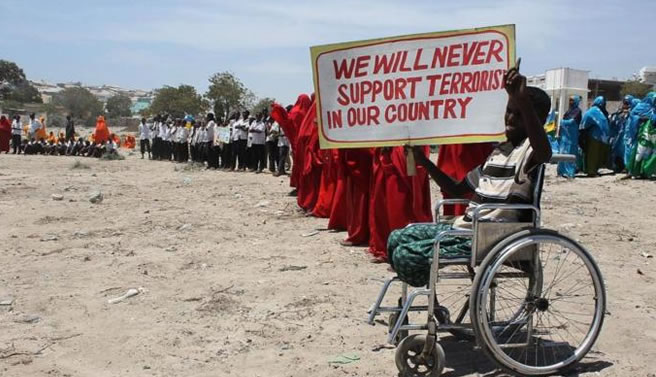Al-Shabab and the party balloon effect
As a result of decades of exploitation, the Somali people are sick and tired of always being the expendable pawn.
 Ethiopian-led
AMISOM, together with the Somali government forces, have captured
several strategic towns previously ruled by al-Shabab, writes Arman
[AFP]
Ethiopian-led
AMISOM, together with the Somali government forces, have captured
several strategic towns previously ruled by al-Shabab, writes Arman
[AFP]
 |
Thursday, March 20, 2014
From the outset, let me make one thing clear: Al-Shabab and its
extremist world view is neither constructive nor sustainable. This
extremist neo-Islamist group represents one of two nihilistic worldviews
that dominated the 21st century political discourse - global
(dysfunctional) jihadism and global war on terrorism.
Both, due to their applied mantra - with hammer, all problems are
solvable - are destined to self-destruct. What has been happening in
Somalia is not entirely devoid of that mindset that justified senseless
violence across the globe in recent years.
In recent weeks, Ethiopian-led AMISOM , together with the Somali
government forces have captured several strategic towns previously ruled
by al-Shabab. There was not much resistance there and that is hardly
surprising since, in the past few years, that has been al-Shabab's
favourite tactic - melt or move, depending on geographic and clan
dynamic.
The chase is on
Though it is too early to forecast how the current military odyssey
might turn out, I would venture to say, contrary to the declared
objective of eradicating al-Shabab, it would cause more political,
security and humanitarian problems, simply because the necessary
environment for such success has not been cultivated.
Granted, al-Shabab could not have been more vulnerable as a host of mainly internal issues have divided the group.
Defeating them would require a grand strategy made of thoroughly
coordinated political, humanitarian, military and economic plans in
order to effectively prevent any vacuum or post liberation zero-sum
politicking that seldom benefits Somalia. This, while creating space for
dialogue.
In theory, there is such coordination; in reality there is no such
thing for these factors. On the internal side, mainly due to a
fundamental misjudgment of priorities that puts genuine reconciliation
on the back burner, the federal government, and by extension AMISOM, are
viewed by some key political entities and actors as an intrusive
partnership.
On the external side, the interests of the de facto twin engine that
propel AMISOM - Ethiopia and Kenya - and the other twin engine that
propel the international community which pays the bills - US and UK -
are at odds. While there is a facade of civility between these four key
actors, there exists among them a political passive aggression that
underscores the impending collision.
On the peripheral side, there are shadowy elements who apparently
view "manageable insecurity" as a good business. Not even the Somali
government knows to whom most are accountable.
Hearts and minds
As ever, competition for the hearts and minds of the masses is in
full swing. In a recent statement aired by the Voice of America - Somali
language program, al-Shabab's leader, Ahmed Godane, describes the
current military campaign as "a proxy war in which US, after it was
defeated in Afghanistan and Iraq, uses Ethiopia for the second time (to
advance its interests)".
The first objective, according to him, is to "Divide what's left of
Somalia between Ethiopia and Kenya in ways masqueraded as regional
administrations".
He urged Somalis to wage Jihad against Ethiopia, AMISOM, the Somali government and US.
On their part, the AMISOM spokesperson has beenon many key media
outlets trying to shake off their recently earned image of parasitical
laziness intended to prolong their lucrative engagement.
Concurrently,
AMISOM has launched a relentless campaign on social media.
Anyone who deviates from the official line gets PAS-ed (called Pro
al-Shabab). Still none could be more effective than Ethiopia's
perception management.
Though nothing has changed as far as its policy toward Somalia is
concerned, it apparently has rebranded its image. So effective has its
rebranding been that it dramatically increased the number of its Somali
political clientele.
Much of the credit goes to the diplomatic finesse of its foreign
minister, Tedros Adhanom, whose style I call Injera Diplomacy. Injera is
a spongy Ethiopian flatbread served with a variety of meat and
vegetable stews. With it one can easily scoop much of the stew one bite
after another without dirtying one's hand.
Make no mistake; Ethiopia is the hegemon of The Horn. As such, it is
on a constant quest to expand its sphere of influence, and, in the case
of Somalia, its subdivision of subjugation.
The Jubbaland initiative hook
The highlight of Foreign Minister Tedros Adhanom's Injera Diplomacy
was the brokering of what's known as the Addis or Jubbaland Peace
Agreement or between the federal government and the advocates of
establishing yet another region that could further Balkanise the nation
in its inevitable demand for autonomy.
The so-called peace agreement, delivered on an IGAD silver plate, was
full of holes that would not only make it unsustainable but, one may
argue, was engineered to lure the central government into a deep
political ditch.
Though neither the government nor the Jubbaland leadership have
sought a two-year interim agreement, in hindsight, that conspicuously
short span was convenient for the architects (Ethiopia and Kenya) as it
expires during the busiest and indeed most politically charged period -
one year before the end of the current government's term.
By the same token, it would embolden other clan-based entities to
mimic the Jubbaland blueprint for breakaway. This, needless to say,
would compel the government to beg for yet another reconciliation fix as
it has before the New Deal conference.
The whole thing was a PR sham and an entrapment. From its inception,
the Jubbaland initiative has been nothing more than "a shotgun wedding"
that would not solve any problem.
Hardly a few days have passed before the Jubbaland breakaway model
was being implemented. In the city of Baidao alone, two parallel
conferences have produced two different presidents with overlapping
authorities, constituencies and territorial claims.
Both inter and intra-clan bloodshed is looming. Guess who is going to come to the rescue? Ethiopia, of course.
Strategy of self-annihilation
Over the years, al-Shabab has made a number of strategic errors that
caused death and destruction. They are on course to repeat history once
again.
Godane is fundamentally wrong in his assessment. Going back to the
aforementioned two couples (Ethiopia and Kenya) and (US and UK), while
they all are on the same page in defeating al-Shabab, they do not have
the same geopolitical and geo-economic interest or strategy.
Ironically, the African couple see it's in their strategic best
interest to permanently bury the Somali state and nurture the
mushrooming clan-based paper tiger para-states that pose dangers only to
themselves.
On the other hand, though they have made their respective
contributions to further complicate issues, by and large, the Western
couple have been trying to resuscitate the Somali state for their own
strategic purposes.
While counter-terrorism, piracy, and geopolitics make headlines, it
was the relentless lobbying effort of a few major oil companies, eager
to reclaim their old contracts (now in highly contested areas), and
international institutions such as International Monetary Fund and World
Bank, eager to reclaim their old loans and fat interests, that made it
happen.
It is important to note that this particular coalition which has
considerable influence on the international community is growing very
impatient.
Meanwhile, the federal government and all regional or autonomous
para-states have been on a dizzying signature frenzy that produced
nothing more than colourful and indeed highly contested contracts,
agreements, and treaties that further complicate the issue.
'What then?'
Though the majority of Somali adults still lament their collective
failure to mitigate the raw (clan-stirred) emotions that ultimately
destroyed the state, and along with it law and order, we are bound to
repeat those mistakes.
Failing to ask "what then?" has opened the gates of chaos and famine; and the rest is a seemingly endless dark history.
So, what is the strategy when the "party balloon effect" changes the
reality on the ground? Common sense dictates by squeezing an inflated
party balloon from one side, you would force the inside air to swiftly
migrate to the other side. So sooner or later, al-Shabab would be forced
to migrate and take their show elsewhere (Puntland, Somaliland, etc.),
then what?
Meanwhile, under the current political calculus and on-going military
campaign, the Somali government is shackled into submission, and thus
has zero leverage to impact any change that could be considered good for
Somalia.
President Hassan Sheikh Mohamud and Prime Minister Abdiweli Sheikh
Ahmed must embrace the reality that the only viable leverage they have
is to cultivate trust within the Somali people, who, as a result of
decades of exploitation, are sick and tired of always being the
expendable pawn.
Abukar
Arman is a former diplomat (Somalia's Special Envoy to the US). Arman
is widely published political analyst. His focus has been post-civil war
Somalia, extremism, Islam, and US foreign policy. He is a DiploAct of a
sort (fusion of diplomacy & activism). You may follow him on
Twitter: @AbukarArman and reach him via e-mail: abukar_arman@yahoo.com
Source: Aljazeera

Comments
Post a Comment